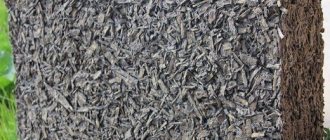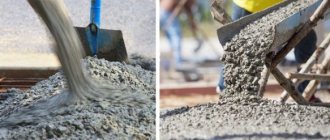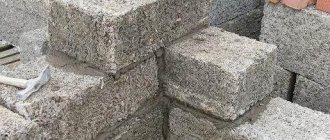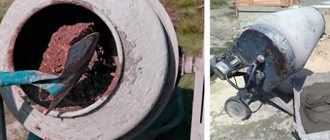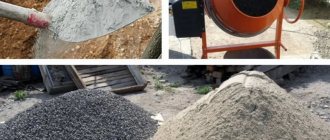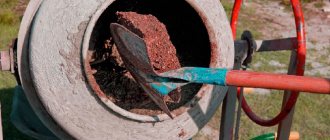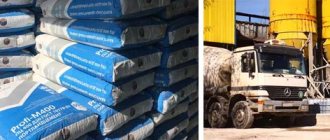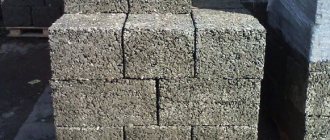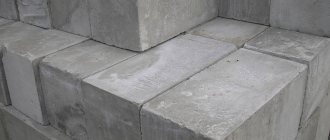You should know that lime increases the mutual adhesive abilities of the components of the sand-cement composite
Solutions for various brands
Depending on the concentration of ingredients, sawdust concrete blocks are divided into the following grades:
- M5.
It is characterized by a density reduced to 0.6 t/m3 and a reduced thermal conductivity coefficient of 0.18. For one 50-kilogram bag of cement, you need to take 0.2 tons of sawdust and lime, as well as 20 kg of sown sand; - M15.
Density and thermal conductivity increase and amount to 0.8 t/m3 and 0.24, respectively. To prepare 50 kg of cement, 70 kg of tyrsa, 30 kg of lime and 115 kg of sand are added; - M20.
The specific density reaches 0.95 t/m3, and the thermal conductivity coefficient increases to 0.3. Sawdust concrete is prepared by mixing 50 kg of cement and sawdust with the addition of 130 kg of sand and 15 kg of lime.
M10.
The thermal conductivity coefficient is 0.21, and the specific gravity increases to 0.8 t/m3. To prepare a bag of Portland cement, you need to mix it with 100 kg of shavings and 100 kg of sand, and also add 80 kg of lime;
As the grade of sawdust concrete increases, the coefficient of thermal conductivity increases and the density increases. High grade blocks allow the construction of enlarged rooms in which, due to the high thermal conductivity coefficient, it is difficult to maintain a comfortable temperature regime. The introduction of special additives, soaking wood raw materials in liquid glass and lime milk allows the use of raw materials with increased humidity and increases the fire resistance of the blocks.
Brand M10 requires the following quantities: half a bucket of binding material, a bucket with a heap of purified sand and a little more than three buckets of shavings
The readiness of the mixed components is determined by squeezing the prepared mixture with the palm of your hand. Plastic and ready for molding, the material retains fingerprints, which indicates that the solution is ready for pouring.
Adding clay to the solution instead of lime
It is allowed to introduce clay into the composition of the material instead of lime, which does not affect the quality of the products. The technology for using clay involves the following steps:
- mixing wood raw materials with Portland cement and sand mass;
- introducing clay dough into the mixture, mixing thoroughly;
- adding water in small doses;
- mixing the composition to a working consistency.
The proportions of lime and clay dough specified in the recipe remain unchanged.
Sawdust size
Despite the fact that a number of sources note the need to sift sawdust on a sieve with a square cell measuring 1 cm, the size of the shavings used is not of fundamental importance.
It is important to pay attention to the following points:
- wood raw materials, which are a binder, should be introduced in the required quantity;
- it is problematic to obtain a homogeneous composition when using sawdust, the size of which differs hundreds of times;
- wood shavings from calibrating machines and rounding equipment are not used in the production of sawdust concrete;
- It is advisable to use sawdust from a sawmill equipped with a band saw or circular working tool.
Fatty solutions containing an excess amount of binder are less susceptible to sawdust coarseness compared to lean compositions.
Sawdust concrete. Sawdust and composition. Advantages and disadvantages. At home
Sawdust concrete is a lightweight concrete consisting of a mixture of water, cement, lime, clay, sand and sawdust. It is used for the production of building blocks and the construction of monolithic buildings. The composition of the material is similar to wood concrete, but contains finer wood filler. The use of sawdust concrete is environmentally feasible, since it is completely safe, meets sanitary and hygienic requirements, and is also characterized by increased thermal insulation and sound insulation.
Where is sawdust concrete used?
The material is widely used in the construction of low-rise residential and non-residential buildings. Most often it is used in the construction of country houses, garages, and outbuildings, the facades of which are planned to be plastered, covered with siding, and clapboard.
The load-bearing characteristics of the material exclude the possibility of its use for the construction of multi-story buildings. Sawdust concrete can be used to build boxes up to 2 floors high. To use it when laying taller buildings, precise engineering calculations are required, as well as pouring a reinforced concrete reinforced belt along the entire contour.
A rough floor screed is often made from sawdust concrete. For this purpose, material of small grades M5 and M10 is used. Plank floor logs, laminate, parquet, etc. can be laid on top of the screed. The screed is compatible with water and electric heated floor systems.
Advantages of sawdust concrete
The main advantage of the material is the use of recycled materials in its production. At the same time, sawdust in concrete does not burn or rot, and therefore does not have its main disadvantages. Their use in the production of sawdust concrete makes it cheap and accessible.
In addition to the benefits of rational use of sawmill waste, the choice of sawdust concrete for construction has other positive aspects:
- High heat-protective qualities.
- Good sound insulation.
- Light weight of constructed structures.
- High tensile strength.
- Fire resistance for several hours at a flame temperature of 1200°C.
- Simple cut.
This is an almost ideal building material that meets modern sanitary and hygienic standards. Although it contains wood fibers, in a cement environment they cannot act as a substrate for the growth of mold and mildew, of course, in the absence of excessive humidity. The thermal insulation qualities of the material deserve special attention. A wall made of sawdust concrete with a thickness of only 30 cm is comparable in heat-insulating properties to brickwork 1 m wide. Houses made of sawdust concrete are warm, and their maintenance for heating and air conditioning is cheaper.
Compared to classic concrete, sawdust concrete is an order of magnitude lighter. Its use in construction makes it possible to pour a lighter foundation, which significantly reduces the overall construction cost. In addition, walls made of sawdust concrete can withstand impacts, tension and bending. Cracks appear on them much less often than on masonry made of brick, cinder block, gas block, and foam concrete.
Walls made of sawdust concrete do not burn. Although they contain wood, they are able to withstand direct exposure to a flame at a temperature of 1200°C for at least several hours. In this case, the surface simply chars, releasing a small amount of smoke. When charring, the wall gradually becomes thinner, which happens extremely slowly.
A positive aspect is the ease of working with sawdust concrete blocks and panels. If necessary, they can be easily cut with a hacksaw or chainsaw. This is very important to follow the installation step. In the future, a wall made of such material will perfectly hold self-tapping screws without dowels. You can safely hang air conditioning, kitchen cabinets, and shelves on them.
Disadvantages of sawdust concrete
The main and only disadvantage of sawdust concrete is its level of moisture absorption. Depending on the density of the material, absorbency can range from 8 to 12%. Even when special water-repellent compounds are added to the sawdust concrete solution, the level of moisture absorption can decrease by only 2%. That is why buildings made of such concrete must have roofs with wide slopes, which eliminates the possibility of the facades getting wet.
Strong absorption of moisture also creates certain difficulties during construction. The masonry needs high-quality covering with film during precipitation. It is also not recommended to carry out construction with material stored in the open air, not even protected by a canopy. It is much heavier and does not have the maximum brand strength.
Requirements for sawdust for the production of sawdust concrete
Any sifted sawdust can be used to make sawdust concrete, but the further performance characteristics of the solution depend on their quality. The most successful solution is the use of sawdust with a particle fraction of 1-5 mm from coniferous trees. The most durable is sawdust concrete based on spruce sawdust. The filler used must be sifted. The presence of wood dust reduces the binding properties.
The composition and fraction of sawdust affects the rate of hardening of the material. Wood contains sugar, which affects the performance of cement. Its concentration determines how quickly a sawdust concrete product becomes strong enough for use. When using Christmas tree sawdust, the surface will harden in 10 hours. When using pine recyclables, it takes 15 hours, and when adding hardwood sawdust, the concrete hardens in at least 4 days.
To reduce the effect of sawdust on cement, they can be pre-treated. For this purpose, specialized chemical compositions or conventional outdoor aging are used. Softwood sawdust can oxidize in the sun within 3 months, after which it acquires the necessary qualities for the production of solid, durable sawdust concrete. You can speed up this process by keeping them in water and then completely drying them under natural sunlight.
Soaking and drying are used only for artisanal home production of sawdust concrete for one’s own needs. In its production on an industrial scale, treatment with liquid glass and calcium chloride is used. The addition of liquid glass helps harden the sawdust, and the inclusion of calcium chloride increases their strength. Industrial manufacturers may also use aluminum chloride, sodium sulfate, or ammonium nitrate. Such solutions make production more expensive, since the chemicals are used in a ratio of 1 to 40 parts of sawdust.
Sawdust concrete at home
The vast majority of sawdust concrete blocks on sale are a handicraft product. There are practically no large enterprises producing this material in full compliance with the current GOST requirements. The majority of the material sold on the market does not at all meet the declared characteristics and the minimum requirements necessary for construction.
The low cost of sawdust concrete production makes its use in construction profitable, so they often produce it in the required quantities themselves, directly on the construction site. In this case, sawdust concrete is poured into the formwork in stages. It is placed in layers. As the formwork dries, it gradually rises upward, resulting in load-bearing walls and partitions of the building. This is a rather long and painstaking process. The material gains final grade strength only after 3 months, despite the fact that the cement itself reaches maximum binding properties after 28 days.
Characteristics of sawdust concrete.
Characteristics of a reinforced concrete block for the basic composition of the mixture.
| Indicator name | Meaning | A comment |
| Strength, kg/cm2 | M 35 | Considerable strength, given the low specific gravity and the resulting low load. Strength can be increased by increasing the cement content. The sawdust in the block plays the role of reinforcement. This results in increased tensile and flexural strength. In this indicator, sawdust concrete blocks are superior to most building materials. It can be adjusted by changing the ratio of binder and filler. In high-rise construction, it is possible to use cement grade M-500, increase its content in the block and use modifying additives. This will allow achieving strength indicators of 100 kg/cm2. When constructing one-story buildings, an indicator of 20 kg/cm2 is sufficient. When producing blocks with such characteristics, significant savings in expensive cement can be achieved. |
| Volumetric weight, kg/m3 | 1100 | As the percentage of cement in the mixture increases, the volumetric weight and strength will increase. |
| Thermal conductivity, W/m*K | 0,29 | The indicator is better than that of brick and concrete. According to this indicator, it is preferable to brick and concrete. Thermal conductivity increases with increasing cement content in sawdust concrete. The use of hollow blocks in construction reduces the thermal conductivity of walls and makes the house warmer. |
| Frost resistance, cycles | 50 | The material can withstand 50 cycles. Special measures can increase the resource. |
| Shrinkage, mm/m | 0,5-1,5 | A fairly high value that makes finishing work difficult. |
| Water absorption,% | 8-12 | A high value, which also negatively affects frost resistance. It can be reduced by using water-repellent additives and treating sawdust with water-repellent and preservative compounds. |
| Vapor permeability | 0,1-0,26 | The value increases with the % of sawdust content and the degree of hollowness of the blocks. |
| Fire resistance, hour | 2,5 | Refractory material of group G1. |
| Cost RUB/m3 | 1800-3500 | Depends on the cement content in the mixture and the degree of voidness. |
| Soundproofing | high | It grows with increasing % of sawdust content. Lightweight cellular concrete, including aerated concrete, with a significant increase in porosity, can have better sound insulation, but at the same time they will lose strength. |
| Maximum number of storeys of the building, floor | 3 | The number of storeys can be increased by increasing the strength of the block by increasing the % of cement content and using modifying additives. |
Composition and characteristics of sawdust concrete
The material consists of the following components:
- binder (cement);
- organic filler (sawdust);
- sand;
- lime or clay.
Specialized additives can be used to improve the adhesion of the components (calcium chloride/nitrate, aluminum sulfate, liquid glass).
Physical, technical and operational characteristics of building blocks made of sawdust and cement:
- density – 400-850 kg/m3;
- thermal conductivity – 0.07-0.19 W/m °C;
- sound absorption coefficient – 0.5-0.7;
- vapor permeability – 30-40%;
- mechanical strength – grade B0.5-3.5;
- frost resistance – 50 cycles;
- fire resistance – non-combustible material.
Physical characteristics and composition of sawdust concrete
This material belongs to the class of lightweight organic concrete. Its compressive strength does not exceed 20 kg/cm2 (M20).
Volumetric weight (density) depends on the ratio of raw materials and varies in the range from 500 to 950 kg/m3.
In terms of its energy-saving indicators, it is comparable to wood and gas silicate - environmentally friendly and warm wall materials.
The frost resistance of walls built from sawdust concrete blocks is quite high and averages 50 freeze-thaw cycles.
Houses made of sawdust concrete are fire safe. The wood in this material is inaccessible to fire because it is covered with a layer of cement mortar. Field tests have shown that such a wall can withstand heating up to 1200 degrees for several hours.
Despite the high organic content, sawdust concrete is bioresistant. This is explained by the fact that sawdust, when mixed, is treated with lime, which eliminates rotting processes.
The composition of this material, as we have already said, includes cement, sawdust, shavings, sand, lime or clay.
By varying their percentage, blocks of the required grade strength are obtained.
The recommended proportions of the initial mixture (per 200 kg of sawdust) are shown in the table.
Table Dependence of the brand of blocks on the ratio of raw materials
Classification of sawdust blocks
Sawdust concrete is used to make wall blocks (for the construction of external and internal walls) and partition blocks (for the installation of partitions). The blocks differ:
- full-bodied (without voids, have greater weight and density, retain heat worse and dampen sound waves);
- hollow, with through and blind voids (less dense and durable, they dampen noise well and retain heat).
According to GOST 6133-99 “Concrete wall stones. Technical specifications" enterprises produce sawdust concrete blocks of the following sizes:
- wall – 288x288/138x138, 390x190x188, 190/90x190x188 mm, 290x190x188;
- partition – 590/190/90x190x188 mm.
It is also permitted to produce products of other sizes upon agreement with the customer.
Depending on the density, sawdust concrete is divided into two types:
- structural (density D500-850);
- thermal insulation (density up to D400).
Making blocks from sawdust and cement
When planning to make sawdust concrete blocks yourself, you should determine the requirements for the strength of the material. The ratio of components and the amount of water when preparing the mixture depend on this.
| Strength grade | Components (in parts by volume) | |||
| Sawdust | Sand | Cement | Lime | |
| M10 | 3,2 | 1,1 | 0,5 | 0,7 |
| M15 | 3,9 | 1,5 | 0,6 | 0,4 |
| M25 | 3,2 | 1,4 | 0,5 | 0,4 |
There are two methods of kneading:
- Water and cement are mixed, then the remaining ingredients are added in portions.
- The dry ingredients are mixed and then water is added.
To test the finished solution, it is recommended to squeeze a small amount of the mixture in your fist. If there is an excess of moisture, it is squeezed out; if there is a lack of water, the mixture crumbles, as soon as you unclench your hand.
Manufacturing technology
To work, you will need a small concrete mixer and split molds made of wood 20 mm thick and lined with metal sheets on the inside. This will make it easier to remove the blocks after the cement has set.
Please note: sawdust concrete shrinks during the drying process, so the size of the forms should be 10% larger than the calculated dimensions of the finished blocks.
- The mixture is prepared in compliance with the proportions of the components and using water without polluting particles.
- Forms are being prepared. If you need to make voids in the blocks, use tubes made of twisted roofing felt.
- The mixture is poured into molds; during the process it is required to compact it layer by layer.
- After the cement has set and the blocks have partially hardened, they are removed from the molds and sent to dry in a ventilated area. Drying period - at least one month.
To test sawdust concrete blocks for strength, the product is dropped from a height of up to 1 meter. The finished high-quality block does not deform or crack.
Manufacturing
The step-by-step procedure for filling blocks looks like this:
- preparation of sawdust: soaking, processing, drying, sifting;
- mixing concrete mortar in compliance with proportions;
- laying out the mixture in molds, tamping;
- gradual drying.
Preparation of sawdust is necessary to remove sugary substances from them. It is possible to approach this process in two ways - either drying sawdust in heaps for several weeks with 2-3 rinses with water, or using additives to bind sugars. The most common are calcium chloride or liquid glass.
As a base, it is better to take M400 Portland cement and river or quarry sand of different fractions to set with the wood component and form a durable cement stone. For better setting and additional preservation of wood, slaked lime is added to the solution. The proportions of the components depend on the required brand of mixture. For M10 it is 1:2:1:8, for M15 – 1:1,2:1,2:5, for M25 – 1:1:1,2:4 (cement, lime, sand, sawdust, respectively).
The components are poured into a concrete mixer or tray in the following order: first, sawdust and lime are mixed in the required proportion, then sand and cement are added. Then water is added to the mixture. It is impossible to name the exact proportion of liquid, because wood absorbs it well. You should focus on the condition of the mixture.
When laying out the solution in a mold, it is necessary to compact it tightly, preferably with a mechanical device. This is required in order to avoid voids inside the sawdust concrete blocks. It is recommended to line the surface of the trays with plastic or metal so that the wooden structure does not absorb moisture and dry out the product.
Attention should be paid to drying sawdust concrete so that it fully gains its original strength before construction. Thus, 30% of the strength is gained by drying in a mold for 3-4 days. In the next 3-4 days of ventilated drying under a canopy in the open air, the strength reaches 70%. This is followed by block drying in longitudinal-transverse laying for 2-3 months, also under a canopy or under film. During this time, sawdust concrete gains strength to 90-100%.
Reviews of sawdust concrete
Numerous reviews of blocks made of sawdust and cement confirm the advantages of the building material, the main one of which is its low thermal conductivity. Houses made of sawdust concrete retain coolness well in hot weather, and keep warm in winter, which allows you to minimize heating costs in the cold season. The high thermal insulation properties of the structural material make it possible to do without additional wall insulation.
Advantages
The advantages of sawdust concrete blocks include:
- Strength. The blocks can be used to construct load-bearing walls of buildings up to three floors high.
- Environmentally friendly and safe - the material does not emit substances or microparticles harmful to health.
- Non-flammability. The blocks can withstand two hours of exposure to flame and temperatures up to 1200°C without ignition.
- Vapor permeability. Due to the porous structure, air exchange through the walls is ensured and excess moisture is removed. This provides a favorable microclimate in the house.
- Good noise insulation properties. Walls and partitions absorb sound waves, which contributes to acoustic comfort.
- Frost resistance. Repeated freezing and thawing of sawdust concrete structures does not lead to their destruction.
- Ease of processing. Sawdust concrete is easy to saw and drill, and is resistant to cracking and chipping.
- Ease of installation. The blocks are quite voluminous, and at the same time have a small mass.
- Durability. Provided effective protection from moisture, block structures last for decades.
- Affordable price. The use of production waste (sawdust) significantly reduces the cost of the material.
- Possibility of self-production. Using available organic raw materials, you can make blocks from sawdust and cement with your own hands.
Flaws
An important disadvantage of sawdust concrete is its fairly high moisture absorption. For this reason it is required:
- Before laying the external walls, arrange a base made of brick or concrete with a height of at least 0.5 meters from the level of the blind area;
- provide for the eaves to extend beyond the plane of the wall to a distance of at least 0.5 meters and equip the roof with a drainage system.
External façade finishing is also used as protection against moisture. It is also necessary to add aesthetics to the building, since the geometry of the blocks is unimportant and thick seams have to be made when laying the walls.
The list of disadvantages also includes the length of time it takes to produce blocks from sawdust and cement. At least 3 months must pass from the moment the molds are poured to the use of finished blocks in construction - during this time the material dries and gains strength.
Preparation of sawdust concrete blocks
First, you need to prepare all the necessary tools, so as not to be distracted in the future, prepare all the constituent materials. To do this, use a concrete mixer, since it is difficult to stir the solution with your hands. It is necessary to make room for drying the blocks, sprinkle it with sawdust or sand.
The sawdust is sifted using a sieve, its cells must measure 10 by 10 millimeters, the base material is pre-treated with calcium chloride and dried.
You can make a sieve yourself; to do this, you need to take even boards, adjust them to the desired size and knock them down, this way: the end ones are attached to the side scraps, and self-tapping screws are used as a connection. Then a mesh is placed in the box; if there is none, then they take a sheet of metal and make cells of the required size using drilling.
All additional dry ingredients are thrown into a concrete mixer, stirred, then sawdust is added and, after several turns, water is gradually added.
If all materials are completely dry, then water is needed up to 15% of the batch amount; with low humidity, up to 10% of liquid is used.
The mixture is considered fully prepared when, when it is squeezed in your hand, a lump appears with fingerprints and no water comes out.
After the mixture is prepared and tested, it is placed in special molds, this must be done quickly so that the solution does not harden. When laying, good compaction is necessary, this will remove the void that fills with air.
You can buy molds for blocks or make them yourself, knock down boards 20*20*40 (length, width, height), then the inner side is hung with polyethylene or lined with steel, this is done so that the material does not stick and is easily removed, and the wood does not draws moisture out of the solution. They are installed on a level place, which is previously covered with sawdust, and sawdust concrete is placed, wait up to four days and remove the boxes.
If you plan to pour large blocks, then you need to make forms that will later be easy to disassemble; for the usual size, they can be knocked down in the form of cells.
You can check whether the blocks are ready for removal using a regular nail; the sharp end is drawn across the material; if you get a slight scratch, you can pull it out for further drying.
After this, the blocks are dried for up to three days, they dry completely and gain strength after 90 days.
In order for drying to occur evenly, it is necessary to lay sawdust concrete where the wind blows; if you place the blocks on top of each other, in height, then you need to place a small distance between them. In case of rain, cover the material, preventing it from getting wet.
To make drying faster, you can make holes in the blocks vertically; to do this, attach a cone-shaped plug to them.
